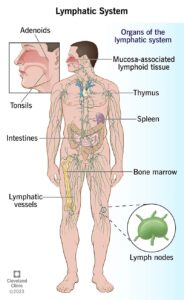Feb 3 on to Anatomy
The cat is from Copenhagen, if that help clear up any confusion!
In the next few days we will explore the mechanics of the Lymphatic System. We will give a general overview and emphasize the parts relevant to us as bodyworkers.
From the Cleveland Clinic
Function
What does the lymphatic system do?
Your lymphatic system has many functions. Its key functions include:
- Collecting excess fluid from your body’s tissues and returning it to your bloodstream. This supports healthy fluid levels in your body. Your lymphatic system also filters out waste products and abnormal cells from this fluid.
- Helping your body absorb fats. Most nutrients can travel through tiny openings (pores) in the walls of your capillaries, and your body can then absorb and use them. But certain fats and other molecules are too large to travel in this way. Your lymphatic system collects fluid from your intestines that contains these molecules and transports it back to your bloodstream.
- Protecting your body against invaders. Your lymphatic system is part of your immune system. It produces and releases lymphocytes (a type of white blood cell) and other immune cells. These cells look for and destroy invaders — such as bacteria, viruses, parasites and fungi — that may enter your body.
So we can already surmise: if lymph is not flowing properly it will build up and get stuck resulting in swelling in the body. Immune System. We talked briefly about this and now we will examine more closely how this operates. On a base level, no matter what symptoms one may be experiencing, a healthy lymphatic system helps us recover and maintain our health. What we do as practitioners to assist the lymphatic system plays an important role for our clients.
Anatomy of the Lymphatic System –
Here is an image of the lymphatic system – we will continue our exploration tomorrow

